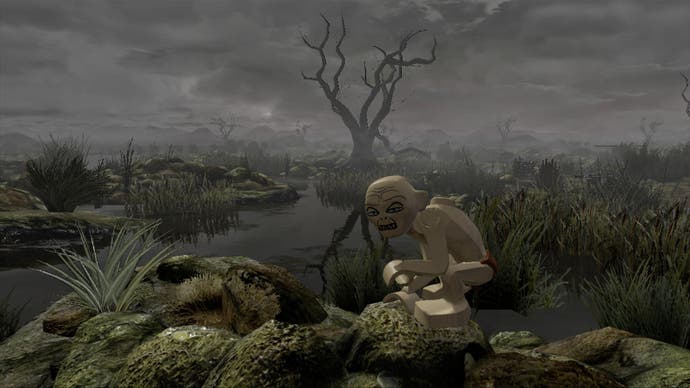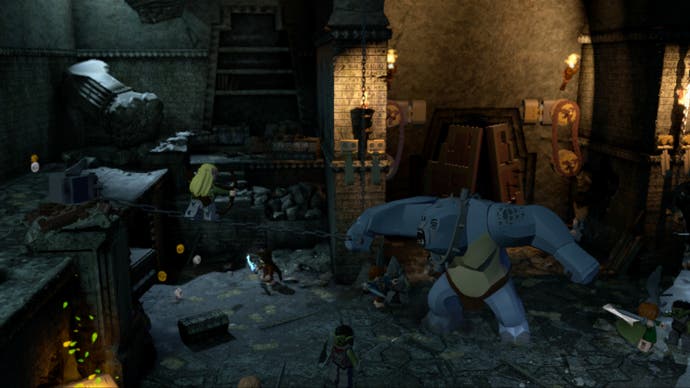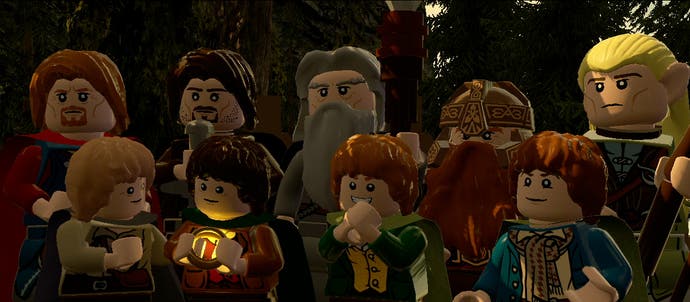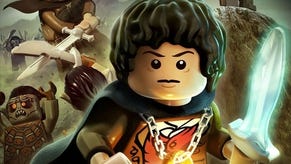Lego The Lord of the Rings review
Hobbit forming.
The Lord of the Rings, it turns out, is the perfect source material for a Lego game. A story in which small things turn out to hold great power and small people prove to have enormous courage, the core ideas of inverted scale that have made TT Games' series so popular are woven through Tolkien's tale like strands in elven rope.
TT has risen to the challenge of adapting such a vast saga with characteristic aplomb. Eclipsing even the sprawling virtual Gotham of Lego Batman 2, this game sees Lego embracing the open-world principle in full. Following an epic prologue that mirrors the battlefield opening of Peter Jackson's movies, you find yourself in the bucolic idyll of Hobbiton, tiny Lego hobbits scurrying around its rabbit-warren lanes, drinking and dancing at Bilbo's birthday party. Beyond its boundaries, a ride on the Bucklebury ferry away, Middle-earth stretches before you in all its dark majesty.
The game eases its young players in, however, with story missions that lead you through the land in a more or less linear fashion. Trails of pale blue studs take you to the next level, but the destination can be changed on the map screen, setting waypoints to whatever point of interest you fancy. Map stones en route act as fast travel points and also mark all nearby collectables and quests when activated.
Despite being a somewhat shrunken version of Tolkien's world, where landmark locations are visible in the near distance at all times, the sense of scale is impressive. You can walk, run or ride to and from anywhere you like, trekking from the Black Gates all the way back to Bag End if you choose. It's not a journey that will take a distractingly long time - this definitely isn't Skyrim - but it feels like an epic undertaking all the same.

The camera has swapped out the elevated view of previous Lego games, opting for a more intimate third-person viewpoint. Appropriately, it feels a lot like those oversized dioramas at Legoland where entire countries are condensed down to their essential features, creating a world that is both thrillingly gigantic and pleasingly cosy at the same time.
The story missions are on more familiar soil, with the tried-and-true template of ability-based exploration, scenery bashing and item collecting you'd expect. That's not a criticism: one of the reasons this series continues to endure is that kids feel comfortable and confident working within rules and systems that remain steadfast whether they're roaming Hogwarts, Tatooine, Gotham or Minas Tirith.
While the core mechanics haven't changed much, their scope has expanded to suit the larger canvas that the Fellowship's journey offers. Characters can carry up to eight items, but also have access to a shared “treasure trove”, a store of 84 additional items that can be found, crafted or forged as you play. You may, for example, have to combine a stick, a hook and some vines to create a fishing rod in one level, but you'll then be able to retrieve that rod from the treasure trove at any time. The same goes for buckets, spades and other basic tools.
You may have to forage for firewood to solve a puzzle. Some items simply extend an ability across all characters, allowing even the smallest hobbit to swing and jump like Legolas. Others offer unique enhancements, such as the Mithril cluster bow, which shoots three arrows at once for maximum destruction. Many more are just for fun: silly hats, novelty weapons that squeak and whistle, or potions and horns that compel characters to dance.
"The game contains multiple chains of supply and demand, all of which serve to lash what were previously separate systems together."

Although the crafting itself is simple, the ramifications burrow deep into the game. The gold bricks of old have been replaced by silver Mithril bricks. These are awarded for completing tasks in story levels, but more are scattered across Middle-earth behind puzzles ranging from the simple to the labyrinthine. Rather than a static accumulation, these bricks can then be smelted down by the blacksmith in Bree and turned into special items based on blueprints.
This means that more intricate sequences of objectives can be set up. Nowhere is this more apparent than the red power bricks, which unlock the score multipliers and cheat modes that make 100 per cent completion possible.
In the earlier Lego games, the red brick that doubles your score would simply be hidden in one of the story levels, waiting to be found. Now, you must first find and speak to the quest giver - in this case a female elf deep in Rivendell. She wants a pair of Mithril gloves, for which you need to find the relevant blueprint. That can only be found by replaying the Warg Attack level in Free Play, using three character types together to retrieve it. With blueprint in hand, the smith in Bree takes four of your Mithril bricks and forges them into the gloves. Hand these over to the Rivendell elf and the red brick appears, ready to be unlocked - provided you have 250,000 studs in the bank.

That's just one example out of dozens, as the game contains multiple chains of supply and demand, all of which serve to lash what were previously separate systems together. Much of this is only possible once the story missions are completed, after which point you're truly free to explore Middle-earth, using all the characters and abilities not only in the levels themselves but the tantalising world map. Everywhere you look, there are things to find and do, from simple stud-collecting opportunities to enriching secrets. In any game of this size, the act of travelling has to be entertaining in itself, and that's certainly the case here.
Also surprising is how faithful the game is to the story. It's an abridged version, obviously, but by homing in on the core narrative strands, the story levels do a fine job of covering all the important events without feeling disjointed. There are some notable omissions - particularly in the final stages of Return of the King - and some major characters barely feature thanks to their more passive role in the adventure. Arwen, Elrond and Galadriel are present for brief scenes and as unlockable characters, but make little impact. The same is true of Eowyn, whose yearning to be treated as a worthy soldier is reduced to mute grumpy faces, and Denethor, who appears only as a bonus character.
But for every beat the game is forced to skip, it adds others sure to please fans. Characters from the wider Tolkien lore appear as unlockables, with Gil Galad, Gloin, Radagast the Brown and even loopy old Tom Bombadil lurking on the outskirts of the map, waiting to be added to your line-up.
Also adding to the authenticity is the use of dialogue from Peter Jackson's movie trilogy. It's a barmy idea, and one that really shouldn't work with the tongue-in-cheek tone that the Lego games have established. It definitely takes some getting used to, but over time the decision begins to make sense and actually makes this one of the funniest - and most gleefully irreverent - Lego games yet.
"You'll still get a lump in your throat as Boromir pledges his allegiance to 'my brother, my king' with his last breath, even though his heart has been pierced not by an Uruk Hai arrow but a giant plastic banana."

Some lines are delivered exactly as they were in the films, while others are taken out of context to smooth over the abridged story, or just for fun. Hearing the voices of Ian McKellen or Bernard Hill, rich with gravitas, coming from these silly little toys is both hilarious and touching. Perhaps the best example comes as Boromir dies, having given his life to save Frodo, redeeming his own loss of control regarding the One Ring's power. The scene plays out just as it did in cinemas, with Sean Bean and Viggo Mortensen transformed into weirdly expressive little figurines. You'll still get a lump in your throat as Boromir pledges his allegiance to "my brother, my king" with his last breath, even though his heart has been pierced not by an Uruk Hai arrow but a giant plastic banana.
That's the seemingly conflicting tone the game manages to strike throughout, with one foot un-ironically planted in epic fantasy territory and the other in slapstick comedy. The graphics engine won't trouble the grown-up RPGs any time soon, with a lot of texture pop-in as you wander, but it's still capable of taking your breath away as Howard Shore's Oscar-winning score swells around you and a stunning Middle-earth vista comes into view.
The only persistent complaint is that the game occasionally insists on precision jumping that the camera and controls can't really support. This never hinders the story missions, but it does make collecting everything in the wild a bit more frustrating than it needed to be. Even so, you're looking at a game with a completion time so hefty that it exceeds even the extended editions of all three movies; this is a vast and generous game, and one that never stops trying to amuse and entertain.
Arriving so soon after Lego Batman 2, Lord of the Rings suggests that despite a production rate that should have crushed all imagination, TT Games isn't taking its young fans for granted and continues to coax and encourage them to be better gamers. Gotham City may have offered a peek behind the curtain at what a wider Lego world could be like, but Middle-earth throws it wide open. Charming and delightful, faithful to the source yet cheekily irreverent, and packed with features that feed into each other in satisfying ways, The Lord of the Rings marks yet another highpoint in the Lego series.






